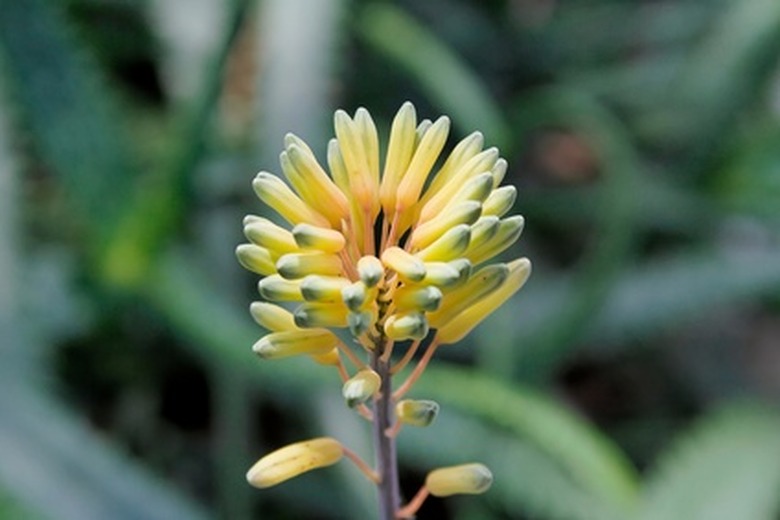Life Cycle Of An Aloe Vera Plant
The famed medicinal aloe (Aloe vera) is a succulent herb with a slimy but soothing sap traditionally applied to soothe skin cuts and mild burns. As long as the Aloe vera is not overwatered or exposed to subfreezing temperatures and is provided lots of sunlight, it will live for years. It will flower and produce seeds as well as young basal plants that can be grown to produce more aloes. You may never run out of plants to supply the remedy to an occasional burn.
Germination
The seed of Aloe vera, when in contact with moist, warm soil, germinates. A seed root first emerges from the seed and extends downward, anchoring the young plant as the first embryonic leaves reach skyward.
Growth
During the heat of the growing season, a rosette of pointed, fleshy leaves that are full of jellylike pulp and sap grows. Leaf edges have spines on them to discourage food-seeking and water-seeking animals from eating the leaves. As long as temperatures never dip below freezing for extended periods, the leaf tissues remain plump and sturdy. A mature Aloe vera grows to a height and width of about 24 inches. At the base of the plant are small, vegetative plant "pups," which grow alongside the mother plant and eventually create a large, clumping mass of Aloe plants.
- The famed medicinal aloe (Aloe vera) is a succulent herb with a slimy but soothing sap traditionally applied to soothe skin cuts and mild burns.
- As long as the Aloe vera is not overwatered or exposed to subfreezing temperatures and is provided lots of sunlight, it will live for years.
Flowers
In late winter to midsummer, depending on climate, a mature Aloe vera sends up a tall, slender flower spike from the center of its rosette of leaves. At the tip of the spike is a cluster of small, yellow, tubular flowers that are naturally pollinated by hummingbirds in Africa. Outside of its native range, other species of hummingbirds pollinate the Aloe vera. Because they are not instinctively familiar with the Aloe flower, however, pollination is not always guaranteed.
Seeds
Pollinated flowers develop into a small green pod that resembles a grooved, fat cucumber. As the pod matures, it dries and browns, splitting open to release seeds to the soil below. The seeds remain dormant until conditions are optimal for their germination.
- In late winter to midsummer, depending on climate, a mature Aloe vera sends up a tall, slender flower spike from the center of its rosette of leaves.
- At the tip of the spike is a cluster of small, yellow, tubular flowers that are naturally pollinated by hummingbirds in Africa.
Death
Aloe vera plants live for 5 to 25 years if not longer, depending on growing conditions. With mother plants producing both young plant pups at their bases and seeds, many Aloe vera plants often grow in a small area. Only extreme environmental stresses cause the demise of these succulents, such as a hard freeze, decimation by a hungry animal and an extreme drought that finally depletes the Aloe's moisture. Also, flooding causes fungal rot on an Aloe, hastening its death.
References
- "Tropical Flowering Plants;" Kirsten Albrecht Llamas; 2003
- FloriData: Aloe vera
